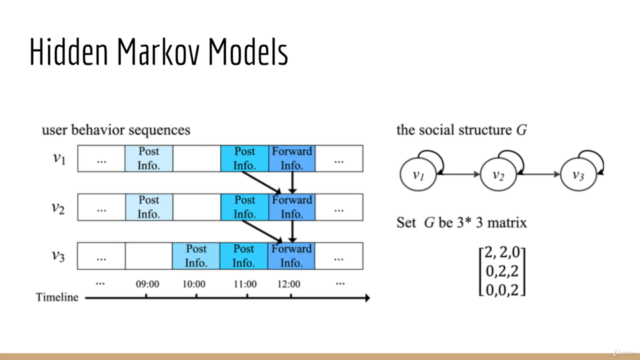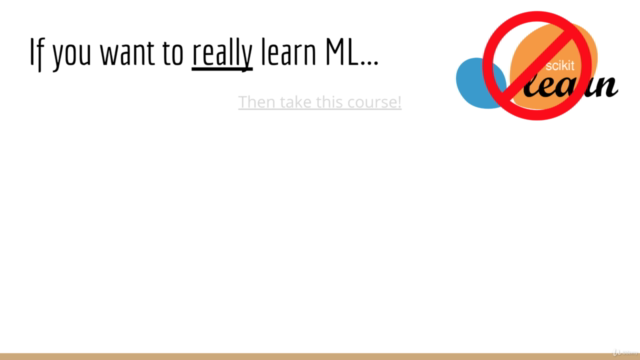Unsupervised Machine Learning Hidden Markov Models in Python

Why take this course?
🎉 Course Title: Unsupervised Machine Learning with Hidden Markov Models in Python
Headline: Master HMMs for Stock Price Analysis, Language Modeling, Web Analytics, Biology, and Beyond!
🎓 Introduction to Hidden Markov Models (HMMs): The Hidden Markov Model (HMM) is a statistical model that explains the mechanisms of stochastic processes that are not directly observable but can be inferred from the observations obtained. It's all about learning sequences, which are ubiquitous in data science. From stock prices to language and beyond, sequences form the backbone of many real-world applications.
💡 The Importance of Sequence Analysis: Consider this: if I wrote a sentence backwards, it would be gibberish to you. This illustrates the crucial nature of sequence order. In data science, being able to analyze and understand sequences is a powerful skill. Whether you're modeling language, predicting stock markets, or assessing credit risk, HMMs provide a framework to make sense of sequential data.
🛠️ Learning with Theano & Tensorflow: This course will guide you through using gradient descent to optimize the parameters of an HMM, offering an alternative to the expectation-maximization (EM) algorithm. You'll learn how to manipulate sequences in Theano and Tensorflow, which are essential libraries for deep learning. This will lay the groundwork for understanding more complex models like Recurrent Neural Networks (RNNs) and Long Short-Term Memory (LSTM) networks.
🌟 Practical Applications of HMMs: We'll explore a myriad of applications for HMMs, including:
- Modeling sickness and health patterns to predict illness duration.
- Analyzing user interactions on websites to improve SEO and reduce bounce rates.
- Applying HMMs in the field of biology to model genetic sequences or protein structures.
🔍 Hands-On Learning Approach: This course emphasizes understanding and implementation over mere usage of algorithms. You'll learn to build and visualize machine learning models internally, which goes beyond the surface-level knowledge provided by APIs. "If you can't implement it, you don't understand it." - Richard Feynman.
🚀 Why Choose This Course? Unlike other courses that only teach you to plug data into a library, this course will have you write the model from scratch. You'll understand the core concepts deeply after working with different datasets, rather than simply repeating the same code 10 times without grasping the underlying mechanisms.
Suggested Prerequisites:
- Calculus
- Linear Algebra
- Probability
- Comfortable with Python coding (if/else, loops, lists, dicts, sets)
- Familiarity with Numpy for matrix and vector operations and loading a CSV file
Order of Learning: For those new to the field, or even experienced learners, here's a suggested order to take the courses:
- Check out the lecture "Machine Learning and AI Prerequisite Roadmap" available in the FAQ of any of our courses, including the free Numpy course.
Join us and dive deep into the world of Unsupervised Machine Learning with Hidden Markov Models! Let's embark on this journey together to uncover the secrets of sequences and make data-driven predictions that can transform industries. See you in class! 📚➡️🚀
Note: This course focuses on understanding and implementing machine learning algorithms, fostering a deeper comprehension of these powerful tools. Remember, the true test of knowledge is implementation. Let's go beyond the surface and unlock the full potential of data science together! 🤖✨
Course Gallery




Loading charts...
Comidoc Review
Our Verdict
<p>This course offers a comprehensive guide for three kinds of tasks in HMM with real code implementation, particularly excelling in the discrete/continuous HMM sections using deep learning libraries. However, some students may find the theory part dull and unengaging compared to external resources like Rabiner's paper on HMMs. The course could also benefit from more explanation of code design maps and improved interaction when addressing student questions.</p>
What We Liked
- Comprehensive guide for three kinds of tasks in HMM with actual code implementation
- Deep learning library application sections for discrete/continuous HMM provide new perspective
- Well-structured course with clear explanations of complex mathematical concepts
- Valuable insights into the mathematics behind Markov chains, language modeling, web analytics, biology, and PageRank
Potential Drawbacks
- Some code sections lack explanation of coding design map
- Code notebooks were removed from the course and access was not promptly provided upon request
- Theory part is dull and unengaging, making it more effective to read external resources such as Rabiner's paper on HMMs
- Author's attitude can be incomprehensible and off-putting